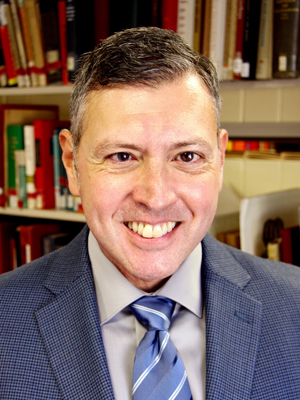Ernesto Chávez is a professor at the University of Texas at El Paso. He lives in El Paso, Texas, and has been a member since 2009.
Website: https://www.utep.edu/liberalarts/history/people/ernesto-chavez.html
Twitter: @ernstchavez
Alma maters: BA, UCLA, 1985; MA, UCLA, 1988; PhD, UCLA, 1994
Fields of interest: Chicanx, Latinx, borderlands, film, sexuality, LGBTQ, intellectual
Describe your career path. What led you to where you are today?
I applied to graduate school because I wanted to learn more history. I was extremely naïve and had no idea what graduate school entailed. While I was finishing my dissertation, several senior scholars informed me that the University of Texas at El Paso was searching for someone in my field. I applied, interviewed on campus, and a few days later I was offered the position. Although I did not plan it, I believe it has all worked out. I realize that I am very fortunate, if not privileged. Given my position, I believe that I have a responsibility to ensure that more working-class, first-generation, and especially Latinx students, not only pursue college and graduate school, but attain their degrees.
What do you like the most about where you live and work?
El Paso is a medium-size city, but feels like a small town. It is fairly easy to navigate. Overall, I really like and admire my students. They are mostly Latinx, working-class, and first generation. As such they are driven and committed to their education despite the many obstacles some face.
What projects are you currently working on?
I am working on a biography of Ramón Novarro, who was a Mexican-born, devoutly Catholic, and gay movie star who gained fame in the silent era and continued his career in "talkies" and television until his violent murder in 1968. This book project seeks to understand how he gained success in Hollywood, and the US in general, in an era of intense racism and homophobia. Examining his life provides a window into the experiences of other, less famous, individuals like him and in so doing we could perhaps understand how race, religion, and sexuality functioned together (and apart) in the early to mid-20th-century US.
Have your interests evolved since graduation? If so, how?
Yes. My dissertation and first book focused on the Chicano movement of the 1960s and 1970s. Later I wrote a book on the US-Mexico War and now I am working on a biography that spans the late 19th century through the mid-20th century.
What's the most fascinating thing you've ever found at the archives or while doing research?
While doing research at UC Berkeley's Bancroft Library I found a letter from José Mojica, a Mexican-born opera singer who became a Franciscan monk, thanking his friend Noël Sullivan for a statue of the Virgin of Guadalupe that was delivered to him in Mexico by their mutual friend Langston Hughes.
Is there an article, book, movie, blog, etc. that you could recommend to fellow AHA members?
I just finished reading Robert Franco's article "'Todos/as Somos 41': The Dance of the Forty-One from Homosexual Reappropriation to Transgender Representation in Mexico, 1945-2001" (Journal of the History of Sexuality 28, no. 1 (2019): 66-95). It provides great insight into a little-known history and the way that popular culture shapes how sexuality and sexual minorities are viewed.
What do you value most about the history discipline?
The research that we do helps us imagine a different kind of past and in the process has the potential to allow us to forge a more emancipatory present and future.
Why is membership in the AHA important to you?
It allows me to be in conversation with a community of individuals who believe that the past is important and has a direct effect on how we live in the present and can forge the future.
Do you have a favorite AHA annual meeting anecdote you would like to share?
During the 2018 meeting in Washington DC I experienced frigid weather. One of my former students had never been to our nation's capital and he was interested in going to the Lincoln Memorial, so I went with him. When we got there, I exited the cab and realized that it was colder than I thought. So, we ran into the monument, stayed there for a few minutes and then emerged back into the cold. I pointed in the direction of the Vietnam Veterans Memorial and said, "It's that way. If you want to see it, I will go back inside and wait." He decided against it. Fortunately, there were cabs parked nearby and so we hailed one and went back to the hotel. The only other time I left the hotel was the next night to have dinner across the street.
AHA members are involved in all fields of history, with wide-ranging specializations, interests, and areas of employment. To recognize our talented and eclectic membership, Perspectives Daily features a regular AHA Member Spotlight series.
Tags: Perspectives Daily Member Spotlight Latin America North America Latinx History Migration/Immigration/Diaspora Women, Gender, Sexuality

This work is licensed under a Creative Commons Attribution-NonCommercial-NoDerivatives 4.0 International License. Attribution must provide author name, article title, Perspectives on History, date of publication, and a link to this page. This license applies only to the article, not to text or images used here by permission.
The American Historical Association welcomes comments in the discussion area below, at AHA Communities, and in letters to the editor. Please read our commenting and letters policy before submitting.
Comment
Please read our commenting and letters policy before submitting.







